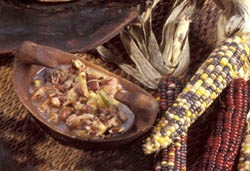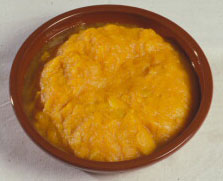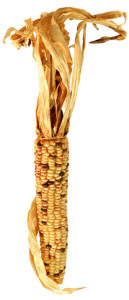 “First Thanksgiving” Foods and Recipes What did they really eat? Popcorn? Read past the recipes to find out! Also visit: Lenape History & Food page and a page on Native Food in General. There are several articles and recipes to enjoy.
“First Thanksgiving” Foods and Recipes What did they really eat? Popcorn? Read past the recipes to find out! Also visit: Lenape History & Food page and a page on Native Food in General. There are several articles and recipes to enjoy.
Sobaheg made with Turkey A Wampanoag Recipe
 Sobaheg is the Wampanoag word for stew. Like most stews, this dish is easily adapted to seasonal ingredients. Variations of this dish are still made in Wampanoag households in New England. Like other cuisines, Wampanoag cookery has continued to evolve, incorporating new ingredients and techniques into the traditional cuisine. Salt is not mentioned in the original recipe, even though it was probably used when the recipe was recorded in 1674. Before trade with Europeans, the Wampanoag got the salt necessary to good health by consuming seafood. After the arrival of the English, salt became a very popular trade commodity with the Wampanoag.
Sobaheg is the Wampanoag word for stew. Like most stews, this dish is easily adapted to seasonal ingredients. Variations of this dish are still made in Wampanoag households in New England. Like other cuisines, Wampanoag cookery has continued to evolve, incorporating new ingredients and techniques into the traditional cuisine. Salt is not mentioned in the original recipe, even though it was probably used when the recipe was recorded in 1674. Before trade with Europeans, the Wampanoag got the salt necessary to good health by consuming seafood. After the arrival of the English, salt became a very popular trade commodity with the Wampanoag.
“Their food is generally boiled maize or Indian corn, mixed with kidney-beans, or sometimes without. Also they frequently boil in this pottag fish and flesh of all sorts, either taken fresh or newly dried. These they cut in pieces, bones and all, and boil them in the aforesaid pottage. I have wondered many times that they were not in danger of being choked with fish bones; but they are so dexterious to separate the bones from the fish in the eating therof, that they are in no hazard. Also they boil in this furmenty all sorts of flesh, that they take in hunting; as venison, beaver, bear’s flesh, moose, otters, rackoons, or any kind that they take in hunting; cutting this flesh in small pieces, and boiling as aforesaid. Also they mix with the said pottage several sorts of roots; as Jerusalem artichokes, and ground nuts, and other roots, and pompions, and squashes, and also severall sorts of nuts or masts, as oak acorns, chestnuts, walnuts; these husked and dried, and powdered, they thicken their pottage therewith.” (Gookin 1674:10)
French-beans, or rather American-beans, the Herbalists call them kidney beans from their shape and effects, for they strengthen the kidneys; they are variegated much, some being bigger a great deal than others; some white, black, red, yellow, blew, spotted…(Wood 16: 53)
Modern Recipe Notes
½ pound dry beans (white, red, brown, or spotted kidney-shaped beans) ½ pound yellow samp or coarse grits 1 pound turkey meat (legs or breast, with bone and skin) 3 quarts cold water ¼ pound green beans, trimmed and cut into 1-inch lengths ½ pound winter squash, trimmed and cubed ½ cup raw sunflower seed meats, pounded to a coarse flour
Combine dried beans, corn, turkey, and water in a large pot. Bring to a simmer over medium heat, turn down to a very low simmer, and cook for about 2 ½ hours. Stir occasionally to be certain that the bottom is not sticking.
When dried beans are tender, but not mushy, break up turkey meat, removing skin and bones. Add green beans and squash, and simmer very gently until they are tender.
Add sunflower flour, stirring until thoroughly blended.
 Pumpkin Recipe for Stewed Pompion (Pumpkin): An “Ancient New England Standing Dish”
Pumpkin Recipe for Stewed Pompion (Pumpkin): An “Ancient New England Standing Dish”
This is a delicious recipe for pumpkin, known as “pompions” to English people in the 17th century (as were all squash.) It is one of the earliest written recipes from New England, from a book written by John Josselyn, a traveler to New England in the 1600’s. (John Josselyn, Two Voyages to New England.)
John Josselyn called this recipe a “standing dish” suggesting that this sort of pumpkin dish was eaten everyday or even at every meal. He called it “ancient” because English housewives had cooked this recipe in New England for a long time. Josselyn also says at the end of this recipe that this food provokes urine and causes gas (windy)!
The Ancient New England standing dish.
But the Housewives manner is to slice them when ripe, and cut them into dice, and so fill a pot with them of two or three Gallons, and stew them upon a gentle fire a whole day, and as they sink, they fill again with fresh Pompions, not putting any liquor to them; and when it is stew’d enough, it will look like bak’d Apples; this they Dish, putting Butter to it, and a little Vinegar, (with some Spice, as Ginger, &c.) which makes it tart like an Apple, and so serve it up to be eaten with Fish or Flesh: It provokes Urine extreamly and is very windy.
Modern Recipe Notes
4 cups of cooked (boiled, steamed or baked) squash, roughly mashed 3 tablespoons butter 2 to 3 teaspoons cider vinegar 1 or 2 teaspoons ground ginger 1/2 teaspoon salt
In a saucepan over medium heat, stir and heat all the ingredients together. Adjust seasonings to taste, and serve hot.
Fact sources: Plymoth Plantation: The Living History Museum of 17th-Century Plymouth; History Channel online. Article & Recipes from Plimoth Plantation http://www.plimoth.org Stop in today!
 Indian Pudding By The Associated Press
Indian Pudding By The Associated Press
This dense, satisfying Indian pudding developed by Kathleen Curtin, a food historian at Plimoth Plantation in Plymouth, Mass., can be baked for 90 minutes for a classic New England dessert. Or, for a 21st century shortcut to an old tradition, the final cooking can be done in the microwave in just minutes.
Despite its name, Indian pudding is not a traditional Native American dish. Native Americans had neither milk nor molasses. But Indian pudding is descended from an Old World staple: hasty pudding, made from wheat flour, barley or oats, thickened with milk.
Adding New World ingredients – corn, a Native American staple, and molasses, from the Caribbean sugar trade – completed the evolution of the pudding recipe into a “true American original,” Curtin says.
INDIAN PUDDING
Start to finish: 2 hours (30 minutes active) Servings: 12
7 cups milk, divided 1 cup molasses 1/3 cup sugar 1/4 cup (1/2 stick) butter 2 teaspoons ginger 1 teaspoon cinnamon 3/4 teaspoon nutmeg 1 cup packed cornmeal (Whipped cream or vanilla ice cream, to serve)
Heat the oven to 350 F. Lightly coat a 9-by-13-inch baking dish with cooking spray.
In a 6- to 8-quart Dutch oven, combine 6 cups of the milk, the molasses, sugar, butter, ginger, cinnamon and nutmeg. Place the pot over medium heat. Scald the milk by heating it until it is just about to boil. The milk will appear curdled; this is normal.
In a medium bowl, mix together the remaining 1 cup of milk and the cornmeal. Whisk this mixture into the Dutch oven.
Bring the mixture to a simmer and cook, stirring constantly with a rubber spatula, for 20 minutes, or until nicely thickened. Be certain to scrape the bottom of the pot to prevent sticking.
Transfer the mixture to the prepared baking dish. Bake for 90 minutes, or until the pudding is set at the center. It may puff during baking, but will flatten while cooling. Let cool slightly before serving with whipped cream or vanilla ice cream.
Foods
 Pilgrims actually used the term “turkey” for all wild birds, so turkey as we know it today could have in fact been any wild fowl — even an eagle.
Pilgrims actually used the term “turkey” for all wild birds, so turkey as we know it today could have in fact been any wild fowl — even an eagle.
In 1621, many of the foods that have become centerpieces of the modern Thanksgiving celebration were absent from the table of the Wampanoag people and pilgrims.
Some surprising omissions from the authentic Thanksgiving menu are ham, sweet potatoes, corn on the cob, cranberry sauce and pumpkin pie.
While meats were a major part of the Thanksgiving feast, pilgrims did not have pigs from which to cure ham. They did however, have an abundance of fish, seafood, birds and venison (deer), which Native Americans provided for the meal.
Sweet treats such as candied yams, sweet potato or pumpkin pie were also absent from the menu. Sweet potatoes had not yet been introduced to New England in the 17th century and although pumpkins were plentiful, they were eaten boiled. The pilgrims’ supply of flour had been used by the time of the feast, so there were no pies or pastries of any kind.
Cranberry sauce, an extremely popular Thanksgiving staple today, also would not have been part of the fare. Cranberries were available to the colonists at this time, but they had no sugar.
Also absent were milk, cider, potatoes and butter. Cows were not available to produce milk and the potato, just discovered at the time, was thought by many to be poisonous.
Corn, unknown to the pilgrims before they met the Wampanoag tribe, was a very important crop. Yet contrary to popular folklore, there was no popcorn at the meal. The corn available to them at that time was maize and flint or flour corn, which was most often used to prepare hominy, and would not have expanded as popped corn.
A more realistic menu for the 1621 feast would have included: fish, berries, watercress, lobster, dried fruit, clams, maize, venison and vegetables such as peas, beans and squash.
No Popcorn: The Question of Popcorn at the ‘First Thanksgiving’
The popcorn problem is a perennial question. It stems from a “First Thanksgiving Day” breakfast scene in a novel by Jane G. Austen, Standish of Standish (1889), p. 281:
“The meal was a rude one looked upon with the dainty eyes and languid appetites of to-day, but to those sturdy and heroic men and women it was a veritable feast, and at its close Quadequina with an amiable smile nodded to one of his attendants, who produced and poured upon the table something like a bushel of popped corn, – a dainty hitherto unseen and unknown by most of the Pilgrims. All tasted, and John Howland hastily gathering up a portion upon a wooden plate carried it up to the Common house for the delectation of the women, that is to say, for Elizabeth Tilley, whose firm young teeth craunched [sic.] it with much gusto.”
It’s a good story, but not good history. The only historic description of the event comes from Mourt’s Relation, a 1622 source, in which there is no mention of popcorn. In addition, this source was forgotten until ca. 1822, and the event, which appears to have been a secular English harvest celebration, was only first described as the “First Thanksgiving” by Alexander Young in his Chronicles of the Pilgrim Fathers (1841) in a footnote on page 231.The event was not a Calvinist thanksgiving of the type celebrated by the Plymouth colonists, which was a religious observance at church, and would not have lasted several days, included non-Christian guests or secular recreations. The Pilgrim 1621 “First Thanksgiving” was thus invented in Victorian times, and the Austen story is hardly reliable historical evidence.
As far as can be ascertained, there was no true popcorn or podcorn in the eastern New England region in 1621 or at the “First Thanksgiving”. It hasn’t been found archaeologically, and there isn’t any New England reference to the popcorn we know today in the 17th century. Sweet corn is documented as only arriving in the region ca. 1779 (Mangelsdof, p. 110), and popcorn may well have arrived in a similar way from the upstate New York area. The presence of the larger flint and/or flour corn in New England is well documented in the studies on corn (such as Paul Mangelsdorf, Corn Its Origin, Evolution and Improvement (Cambridge, 1974); Arthur Parker, “Iroquois Uses of Maize,” in Parker on the Iroquois, Fenton, ed. (Syracuse, 1968); Paul Weatherwax, Indian Corn in Old America (New York, 1954). The first widespread use of corn in the Northeast is now set at ca.1100, A.D. (Bruce D. Smith, Rivers of Change, (Washington, 1992), p. 292), which might account for a fairly specialized selection of maize varieties here 500 years later.
 Flint corn has a hard, corneous endosperm like popcorn and when heated (or “parched”) will expand rather like a half-popped piece of popcorn. We have tried this with several antique and modern varieties. However, flint corn was most often prepared as hominy or samp by boiling, which is the most palatable way to use it, then and now. Historically it was the flour corn, with its soft, floury endosperm, which was favored for parched corn, the process most analogous to popping corn. While one can not be dogmatic on the fact, the assertion that popcorn was part of the quasi-mythic First Thanksgiving should be rejected.
Flint corn has a hard, corneous endosperm like popcorn and when heated (or “parched”) will expand rather like a half-popped piece of popcorn. We have tried this with several antique and modern varieties. However, flint corn was most often prepared as hominy or samp by boiling, which is the most palatable way to use it, then and now. Historically it was the flour corn, with its soft, floury endosperm, which was favored for parched corn, the process most analogous to popping corn. While one can not be dogmatic on the fact, the assertion that popcorn was part of the quasi-mythic First Thanksgiving should be rejected.
